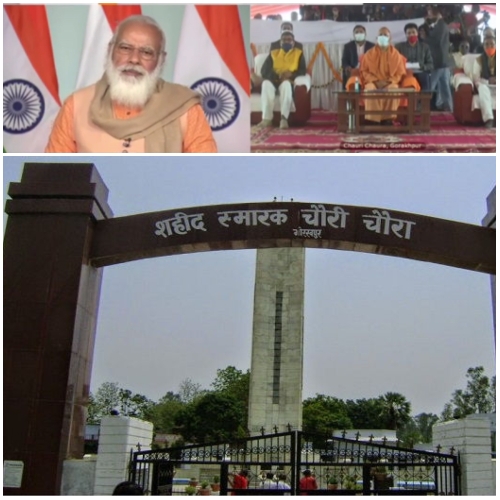Chauri Chaura Centenary- Fire was not just in the station but in hearts of people
Total Views |
Gorakhpur, February 04: Prime Minister Narendra Modi on Thursday inaugurated the Chauri Chaura Centenary Celebrations at Uttar Pradesh's Gorakhpur. He also released a postage stamp to mark the centenary of the event. "It is unfortunate that martyrs of Chauri Chaura incident have not been discussed as much as they should have been. Although, they have not been given significance in pages of history but their blood is in the soil of the country and keeps inspiring us", he said.
"Incident of Chauri Chaura was not limited to a police station being set on fire. Message of the incident was huge. Due to various reasons, it was treated as minor incident, but we should see it in context. The fire was not just in the station but in the hearts of people", PM Modi added in presence of UP CM Yogi Adityanath.

The Chauri Chaura incident took place on 4 February 1922 at Chauri Chaura in the Gorakhpur district of the Uttar Pradesh in British India, when a large group of protesters participating in the Non-cooperation movement, clashed with police who opened fire. In retaliation the demonstrators attacked and set fire to a police station, killing all of its occupants.
The incident led to the death of three civilians and 22 policemen. Mahatma Gandhi, who was strictly against violence, halted the non-co-operation movement on the national level on 12 February 1922, as a direct result of this incident. In spite of Gandhi's withdrawal, 25 freedom fighters died due to revenge jurisdiction by British.
The incident-
Two days before the incident, on 2 February 1922, volunteers participating in the Non-cooperation Movement led by a retired Army soldier named Bhagwan Ahir, protested against high food prices and liquor sale in the marketplace. The demonstrators were beaten back by the local police. Several of the leaders were arrested and put in the lock-up at the Chauri Chaura police station. In response to this, a protest against the police was called on 4 February, to be held at the local marketplace.
On 4 February, approximately 2,000 to 2,500 protesters assembled and began marching towards the market at Chauri Chaura. They had gathered to picket a liquor shop in the market place. Their leader was arrested, beaten and put in jail. Part of the crowd gathered in front of the local police station shouting slogans demanding the release of their leader. Armed police were dispatched to control the situation while the crowd marched towards the market and started shouting anti-government slogans. In an attempt to frighten and disperse the crowd, the police fired warning shots into the air. This only agitated the crowd who began to throw stones at the police.
With the situation getting out of control, the Indian sub-inspector in charge ordered the police to open fire on the advancing crowd, killing three and wounding several others. Reports vary on the reason for the police retreat, with some suggesting that the constables ran out of ammunition while others claimed that the crowd's unexpectedly assertive reaction to the gunfire was the cause. In the ensuing chaos, the heavily outnumbered police fell back to the shelter of the police chowki while the angry mob advanced. Infuriated by the gunfire into their ranks, the crowd set the chowki ablaze, killing all of the Indian policemen and chaprassis (official messengers) trapped inside.
.
.